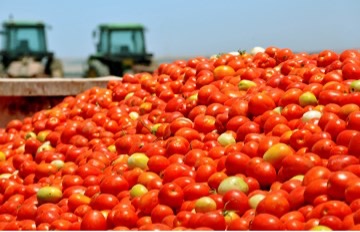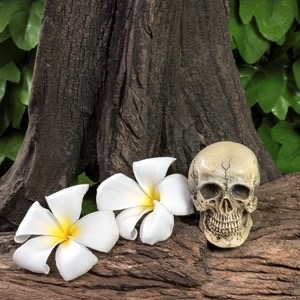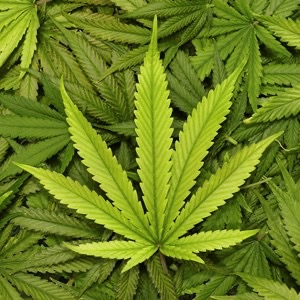- The word “peach” is from the Latin malum Persicum, which literally means “Persian apple.”[14]
- Nearly 1,000 jasmine flowers and a dozen roses go into a single bottle of Chanel No. 5 perfume.[7]
- The earliest gardens were strictly practical and were used to grow food and medicinal herbs. Around 1500 B.C. in Egypt, the first decorative gardens appeared.[20]
- The first greenhouses in history were built in Rome in A.D. 30 under the orders of Emperor Tiberius who wanted to eat a cucumber a day. Andrew Faneuil in Boston built the first greenhouse in North America in 1737.[8]
- Watermelons are actually vegetables and are related to squash, cucumbers, and pumpkins.[6]
- Famous literary works that center their plots on gardens include The Secret Garden, the Dark Materials trilogy, Tom’s Midnight Garden, “The Selfish Giant,” Romeo and Juliet, “The Merchant’s Tale” in Canterbury Tales, La Roman de la Rose, Rebecca, The Door in the Wall, and the book of Genesis in the Bible.[17]
- The name of the flower heliotrope is from the ancient Greek (helios, meaning sun, and trepos, meaning “turning to go into to”) because its leaves and flowers turn toward the sun.[3]

World Naked Gardening Day aims to promote harmony and peace with nature
- World Naked Gardening Day is celebrated on the first Saturday in May. It aims to promote harmony and peace with nature.[2]
- The top 10 most beautiful gardens in the world include 1) Châteaux de Versailles in Versailles, France; 2) Royal Botanic Gardens in Kew, England; 3) Powerscourt Gardens in Enniskerry, Ireland; 4) Butchart Gardens in British Columbia, Canada; 5) Villa d’Este in Tivoli, Italy; 6) Dumbarton Oaks in Washington D.C., USA; 7) Gardens of the Villa Ephrussi de Rothschild in San-Jean-Cap-Ferrat, France; 8) Stourhead in Wiltshire, England; 9) Master-of-Nets Garden in Suzhou, China; and 10) Sanssouci Palace in Potsdam, Germany.[19]
- According to Sir Francis Bacon, gardens are the “purest of human pleasures.”[8]
- When a virus changed the color of tulips in Holland in 1637, people believed that a new type of plant had been discovered—which, in turn, led to a full-blown tulip craze. During this time, one of the prices for a single bulb included a load of grain, 1,000 pounds of cheese, 12 sheep, 10 oxen, 5 pigs, 4 barrels of beer, 2 tubs of butter, 2 hogsheads of wine, a suit of clothes, and a silver cup.[20]
- The name chrysanthemum derives from the Greek words chrysos, meaning “gold,” and anthos, meaning “flower.” Garlands served as protection against demons, and drinking dew from chrysanthemum flowers was supposed to prolong life.[20]

The scientific name for the tomato is Lycopersicon lycopersicum, which means “wolf peach”
- There are at least 10,000 varieties of tomatoes. Over 60 million tons of tomatoes are produced each year, making it the world’s most popular fruit. The second most popular fruit is the banana.[15]
- The iris flower is named after the Greek goddess Iris who carries messages of love from heaven to earth using a rainbow as her bridge. Irises are named after her because they bloom in just about all the colors of the rainbow.[9]
- Gardens and philosophy are often seen as related. Philosophers note the contribution of gardening to the “good life.”[8]
- While ancient Romans and Assyrians were renowned for their beautiful gardens, the value of gardens as an aesthetic place declined during the Middle Ages. Monasteries, however, served to continue the tradition of garden design and the improvement of gardening techniques.[8]
- Gardening can be considered both an art (arranging plants harmoniously) and as a science (applying the principles and techniques of cultivation).[8]
- In ancient Greek mythology, Hyakinthos (a.k.a. Hyacinthus) was the god of spring flowers. The god Apollo adored Hyakinthos, but killed him by mistake. The hyacinth flower sprang up from his blood and, thus, this flower is a symbol of sorrow, sadness, and resurrection.[20]
- The Hanging Gardens of Babylon were one of the Seven Wonders of the Ancient World. They are believed to have been built by the Neo-Babylonian king Nebuchadnezzar II near present day Hillah, Babil province, in Iraq.[20]

“The Poison Garden” is home to over 100 murderous plants
- There is a garden in England called The Poison Garden. It is home to 100 murderous plants. Visitors to this dangerous garden are prohibited from smelling, touching, or tasting any of the plants.[20]
- Dandelions were used as a food source and as a medicine for at least 1,000 years. European immigrants purposely carried seeds to America, where greens were used for salads and teas. Dandelion roots were served as a vegetable course, or were dried and used as a coffee substitute. The flowers were used to make dandelion wine and to make a yellow dye for wool. There has been a recent revival of using the dandelion in these many ways.[3]
- Gardening can prompt the same questions posed by contemporary philosophers of art, such as conceptual ones (“What is a garden?”), ontological ones (“Is a garden simply a complex physical object?”), normative ones (“What makes a garden great or just good?”), and more.[8]
- An herb is from the leaf of a plant. A spice is from the seed, bark, root, berry, or bulb.[6]
- Figs are not always considered vegan. When a fig is pollinated by a fig wasp, the fig flower traps the wasp and then the enzymes in the flower digests the wasp’s corpse.[6]
- A pineapple is actually a berry.[6]

Gardening can improve a man’s sex life
- According to one study, as little as 30 minutes of gardening can dramatically improve a man’s sex life. Weeding, digging, or mowing the lawn for 30 minutes almost halved a man’s risk of impotence.[4]
- “Fruit” is a botanical term, while “vegetable” is a culinary term. For example, botanically, a fruit is a seed-bearing structure that develops from the ovary of a flowering plant. Vegetables are other parts of the plant, such as roots, leaves, and stems. In culinary terms, however, many foods that are botanically fruits but are not typically sweet (such as eggplants, bell peppers, and tomatoes) are considered vegetables by chefs.[6]
- The Gympie-Gympie tree is the world’s most dangerous tree and the most painful of all stinging plant trees. Touching this tree is similar to being sprayed with hot acid, even driving those who have been affected to suicide. One man shot himself after he mistakenly used the leaf as toilet paper.[20]
- While the buttercup looks innocent, it is among the more deadly garden plants. If eaten, this innocent-looking flower can cause painful death resulting from organ and nervous system intoxication.[6]
- The largest flower in the world is the Rafflesia, or “corpse flower.” Its odor is similar to that of a decomposing mammal, which earns this giant flower its nickname. Found in the rainforests of Indonesia, it can grow to be 3 feet across and weigh up to 15 pounds.[6]
- There are over 20,000 species of edible plants in the world. However, just 20 species provide 90% of human food.[15]
- The daffodil’s name is from the Old English, affo dyle, or “that which cometh early,” because it is one of the earliest blooming flowers.[6]

The Romans believed the sap from these flowers had special healing powers
- Japanese gardens are gardens that create miniature landscapes that are often idealized and highly abstract.[8]
- The Old English word geard means “fence” and produced the words “garden” and “yard.”[20]
- The Roman Vitruvius text De architectura libri decem, or The Ten Books on Architecture, is the oldest surviving garden design manual, dating from 27 B.C.[20]
- While modern architects are primarily concerned about the relationship of buildings to money and the flow of cars, ancient architects were more concerned with the relationship of buildings to gardens and landscapes.[8]
- Many religions use gardens as symbols of paradise and immortality. Additionally, the association of gardens with perfection is found in Judaism, Christianity, and Islam.[20]
- The secret to a great garden is the soil, not necessarily the plant. Adding large amounts of organic materials, such as crushed leaves, grass clippings, or homemade compost will help feed and nourish a garden.[9]

In 1619, the British Crown ordered the colonists at Jamestown to grow hemp
- Both George Washington and Thomas Jefferson grew cannabis on their plantations. Jefferson even invented a device for producing hemp in 1815.[12]
- Some fruit trees need a pollinator, which isa similar tree that blooms at about the same time to produce a separate pollen source. Common trees that need other pollinators include apple, pear, and most sweet cherries.[9]
- The “hardiness zone” is the climatic region that best suits a particular plant. The coldest zone is 1 and the hottest is 11. If someone lives in zone 6 and tries to garden a plant rate only to zone 8, the plant will likely die.[9]
- The general guideline for watering a lawn is to apply 1.0″–1.5″ of water each week. Overwatering doesn’t just waste water, it also can wash fertilizer into the area’s waterways, erode the soil, damage the structure of the soil, and make a lawn more vulnerable to disease.[9]
- The word “radish’ is from the Proto-Indo-European word *wrad, meaning “twig, root.” First cultivated in China, radishes, along with onions and garlic were paid as “wages” to laborers who built the Ancient Egyptian Pyramids.[20]
- The bumps on raspberries are called “drupelets.”[21]
- “Pomology” is the study of fruit. It is from the Greek pomum (fruit) + -logy. Someone who studies fruit is a “pomologist.”[16]
- Grapes explode when you put them in the microwave.[18]
- Broccoli is actually a flower. The word “broccoli” is related to the Latin word broccus, meaning “shoot, protruding tooth, small nail,” which also gives us the word “broach.”[11]
- Strawberries are not berries. However, avocados, watermelon, bananas, and pumpkins are.[13]
- Lacanophobia is the fear of vegetables.[5]
- The rose is among the three flowers that are mentioned in the Bible — the other two being the camphire (henna) and the lily.[1]
- Moonflowers unfurl in the evening and stay open until the sun rises. Several varieties of moonflower also give off a lemon fragrance when its flowers are open.[20]
- Lemons are technically berries. Specifically, they are a hesperidium, a berry with a leathery rind.[10]
- June 12 is Red Rose Day. The day honors the flower that symbolizes love and romance. It is also the June birth flower!
